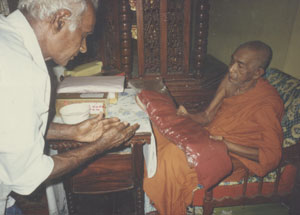The Vas season’s religious activities end today, which is a full moon day. It was on this full moon day (“Il Poya”) that the first sixty Arahants went out to preach the Buddha dharma. On that occasion, (that “Il Poya day”), about 2550 years ago Gautama Buddha, the Perfect One said: “Go ye, O Bhikkhus! go and wander for the welfare and happiness of the many in compassion for the world, for their good and happiness of gods and men. Let not two of you go in the same direction. Proclaim, the dharma that is excellent in the beginning, excellent in the middle, excellent in the end.”
From August to November, when there is more rain than is usual in India and in Sri Lanka, one often hears at dawn on the streets, the reverberating sounds of drums followed by the sound of high pitched flutes. At dawn, several processions headed by dancers take to the streets for several hours.
 |
In these processions devotees carry head high, a robe that is worn by Bhikkhus. This annual feature is seen only during this particular period of the year, in Theravada Buddhist countries. This is one of the most important of Buddhist activities or rites that has been performed for thousands of years.
After the Buddha had preached on an Esala Poya day at the Deer Park, Saranath, to his former companions, the five ascetics to go in search of truth, to end universal suffering (Dukkha) i.e.the Damma Chakka Pavaththana Sutta and illuminate the world with the Noble Eight fold path, in the following month (August) the rainy (Vas) season began. It therefore became necessary that His disciples, who soon grew in numbers remained indoors, listening to discourses given by the Teacher.
The Bhikkhus remained indoors in caves and in “Kutties”. As time passed this retreat became an annual feature. Thus was born the “Vas season” or “rains retreat”, which ends with the full moon (Poya) of October – November.
The “Vas Pinkama” (merit gaining activity spanning three months) is observed in all Buddhist temples and affords an opportunity for both the laity and the Bhikkhus to interact on matters concerning Buddhism.
The temple becomes a hive of activity. This season also gives an opportunity for the laity to look after the daily needs of the Bhikkhus by providing Dane, and looking after those Bhikkhus who are sick. Bodhi pujas, religious discussions, sermons and other religious activity take place in the temple.
Those who actively undertake to care for the needs of the monks and of the temple in general, do so with great piety spending considerable time and money. The needs of the temple, such as effecting minor repairs to buildings and providing of adequate kitchen equipment, is looked into.
The “Vas Pinkama” ends with the offering of the Katina Robe. This is the pinnacle of meritorious conduct of the season. Its importance lies when one considers the merit gained is said to be that great or bountiful, to qualify it, to be the foremost meritorious act one could do.
According to the Buddha word, there are eight great meritorious acts one could do, viz – (1) offering to the Maha Sangha a Katina Robe (Pali – “Cheevara”), (2) offering of Atapirikara, (3) Building and offering a Sanghavasaya (Hall of residence for Bhikkhus), (4) Building a shrine room, (5) offering of land to a temple, (6) writing and offering of Dhamma books, (7) constructing wells in the temple and (8) constructing toilets for use of the Sangha.
Of these eight great meritorious deeds, the offering of a Katina Robe which is carried head high, throughout the streets at dawn in a colourful procession, accompanied by music, is considered the noblest of all meritorious acts one could do. The merit gained by offering Katina Robe cannot be erased easily, and stands good throughout one’s samsara. It is therefore said that such merit is “unshakeable”. The Katina Robe is just not an ordinary robe. It is especially prepared and dyed for the great event, with much piety.
The robe is finally offered to the Maha Sangha, who in turn, in accordance with the Vinaya rules, at a Poyage (seema) ceremony offer it by unanimous decision, to a deserving or virtuous (“Silvath”) Bhikkhu, who during the entire Vas season had observed his vows with piety at the temple.
The offering of a Katina Robe can be done only once a year in each temple and on a particular day, whereas one could offer other robes on any day of the year. Therefore, the merit one gains by this offering is said to be greater than what one would gain by building a stupa and having it crowned with a pinnacle or chaitya. The offering of a Katina Robe also signifies the perpetuation or continuation of the order of the Maha Sangha.
The first sixty Arahants went out to preach the Buddha dharma to all corners of India travelling on foot, from village to village, to dispel ignorance, to announce the rationality of Buddhism; to show the equality of man and women by breaking down Brahminical caste barriers; to give women a better place in Indian society to give them liberation of the mind and to bring happiness and security to all animals, both seen and unseen. |


